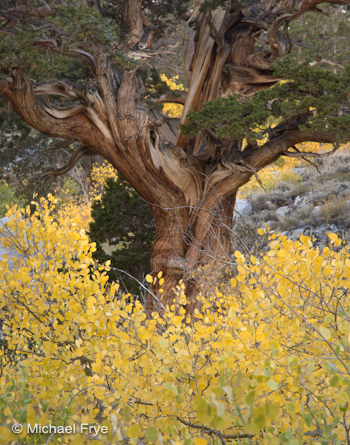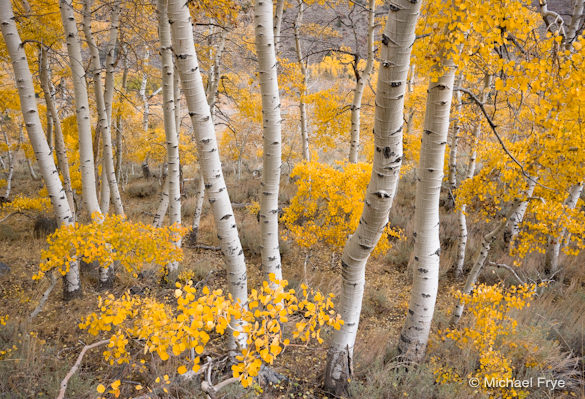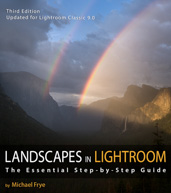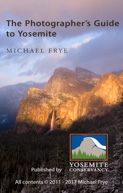Yosemite Photo Conditions
by Michael Frye | Oct 11, 2010 | Yosemite Photo Conditions
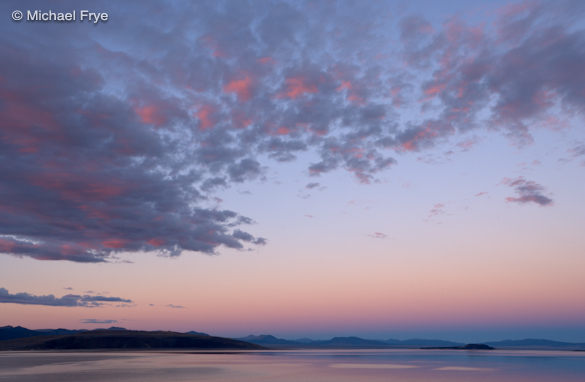
Mono Lake, Sunday evening
Claudia and I finally made it over reopened Tioga Pass on Saturday, and visited the Bishop Creek area, Rock Creek, Convict Lake, June Lake Loop, Lee Vining Canyon, and Lundy Canyon. Most of the aspens in those areas are still green—in fact, many are dark green. I saw more green aspens than I’ve ever seen along the eastern side of the Sierra this time of year. Autumn is very late on this side of the mountains.
The good news is that those green trees appear to be in good shape, and we’re having a spell of warm days and cool, but not freezing, nights—perfect conditions for creating colorful leaves. So when the aspens do finally turn we might see some great color—maybe in another week or two, but these things are always hard to predict.
Now on to some specifics. There is some decent color high up in the Bishop Creek area (west of Bishop) near North Lake and Lake Sabrina. By most accounts North Lake was better a week ago, but there is a band of aspens along the northwest shore that hasn’t completely turned yet. It’s mostly yellow with some green, so it may be better in a couple of days.
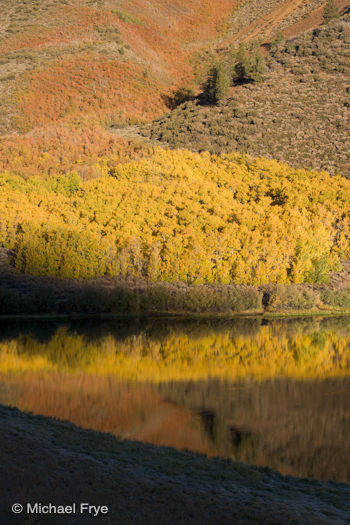
North Lake, Sunday morning
There is some nice color on a hillside above the road in Rock Creek Canyon, but this seems like a hard place to find good compositions. Further north, Convict Lake on Saturday was almost entirely green, as were the June Lake Loop and Lee Vining Canyon yesterday.
Lundy Canyon had probably the best color we found, although it’s not close to peak yet. The lower part of the canyon was about half yellow, half green yesterday. Further up, below Lundy Lake, everything was green. Beyond the “resort,” along the dirt road, there was a nice patch of color on the south side of the canyon near one of the beaver ponds. We hiked up to the highest beaver pond, and found mostly lime-green aspens, but we always enjoy visiting this area.
We’ll be scouting Conway Summit, Virginia Lakes Road, Dunderberg, and other spots between Lee Vining and Bridgeport this afternoon, and I’ll let you know what we find.
I haven’t been to Yosemite Valley since last Wednesday, but I’ll be there in two days and will give you an update. On my last visit it looked like the maples and dogwoods were starting to turn, so I’m anxious to see if they’ve progressed.
Good luck to all you fall foliage photographers! Let me know if you find anything I missed.
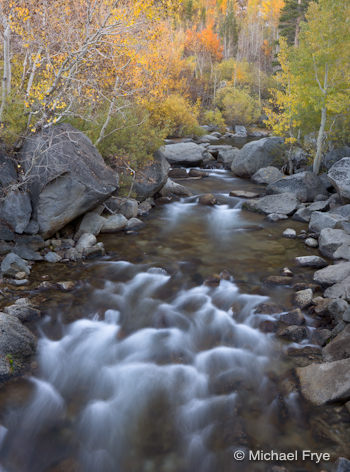
Creek below Lake Sabrina, Sunday morning
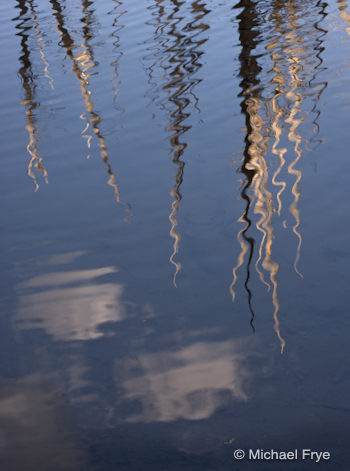
Reflections in a Lundy Canyon beaver pond, Sunday afternoon
by Michael Frye | Oct 11, 2010 | Yosemite Photo Conditions
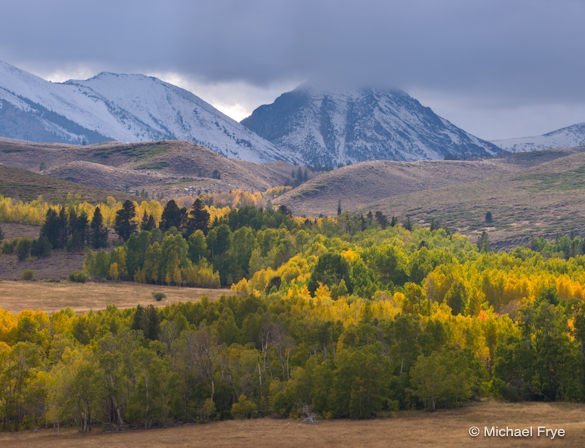
Stormy afternoon over Conway Summit
Claudia and I went up to Conway Summit, Virginia Lakes Road, and Dunderberg this afternoon. This area had the best color we’ve found yet. Conway Summit is still mostly green, as you can see from the photo, but getting there. There are some nice patches of yellow and orange above Conway Summit on the road to Virginia Lakes. Most of the Dunderberg Meadow area (between Virginia Lakes and Green Creek) is still green, but should be good in another week or so. We did find a small patch of red-orange trees nearby. Alas, darkness arrived before we made it to Green Creek—too much to photograph along the way!
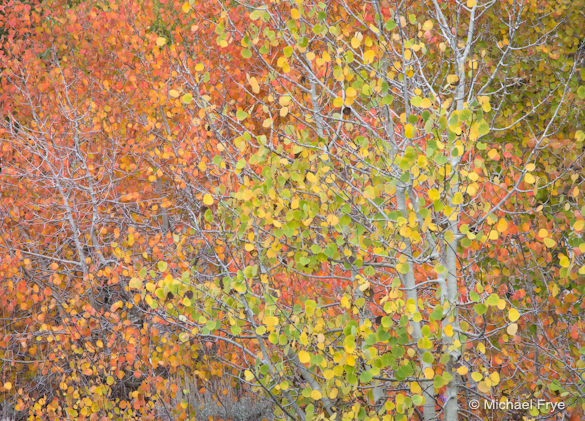
Yellow and orange leaves near Dunderberg
by Michael Frye | Oct 6, 2010 | Yosemite Photo Conditions
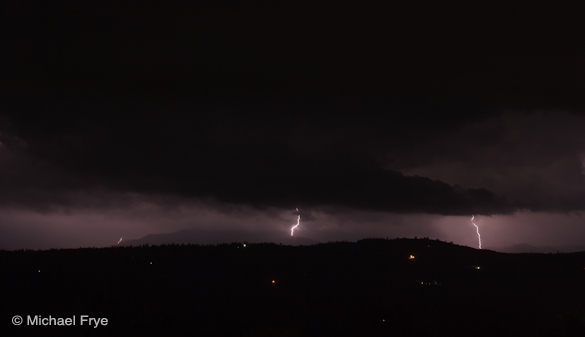
Lightning striking the Sierra foothills near Mariposa on Sunday night
October literally started with a bang, as thunderclaps rang through Yosemite Valley. It poured Saturday afternoon. Near Pohono Bridge the Merced River was brown, filled with silt, something I’ve seen only a few times in the last 27 years.
At about 11 o’clock Sunday night my wife and I got in our outdoor hot tub—a nightly ritual—and immediately noticed flashes behind the ridge to our west. We couldn’t hear anything, but knew it must be distant lightning. The frequency was impressive, a nearly constant flickering.
Even though we planned to head over Tioga Pass to Bishop the next morning, and needed to get up early, we decided to go out and take a look. We drove to a spot on Triangle Road, less than half a mile from our house in Mariposa, with a panoramic view to the south. From there we could see that flickering behind a ridge to the west, but also an even more intense thunderstorm to the south, near Fresno. This second cell put on a great light show, with nearly continuous flashes. It gradually moved closer, then slid by to the east, so we were able to watch it for over two hours.
Of course I tried to photograph the lightning, but unfortunately we saw few bolts hit the ground. Most of the show consisted of cloud-to-cloud lightning, and the streaks were usually hidden within the clouds. But I managed to capture a few good images, including the one at the top of this post.
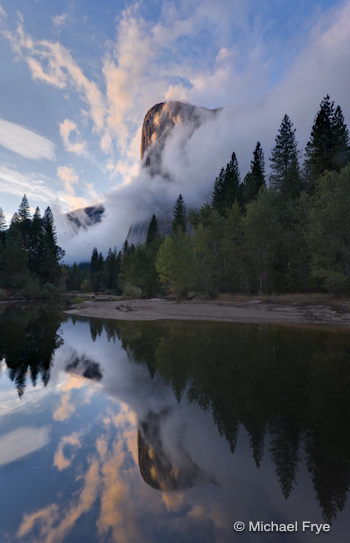
El Capitan at sunset, Tuesday evening
By the next morning rain had changed to snow at the higher elevations of the Sierra, and Tioga Pass was closed. We started driving north to Sonora Pass, but then learned that had closed too. Reluctantly we turned around rather than face a six or seven hour drive to Bishop.
I had to console myself by photographing a beautiful, seldom-visited location: Yosemite Valley. After receiving almost two inches of rain since Friday, skies cleared over the valley Tuesday, and I was able to photograph El Capitan at sunset surrounded by mist and clouds.
Since I never made it to the other side of the mountains, I can’t tell you first hand about the fall color over there, but Evan Russell, an Ansel Adams Gallery staff photographer and one of my workshop assistants, told me that the color is great west of Bishop around North Lake, South Lake, and Lake Sabrina. Or at least it was Monday. Tuesday it snowed up there, and many aspens lost their leaves. Typically a storm will strip most of the trees that are already turning, so it may be another week or two until the trees that are now green will change and provide another dose of fall color.
News like this—that some of the early season aspen spots may lose their leaves—often elicits anxious comments in forums, with people worried that they may have missed fall, and others adding fuel to the angst by saying that if you don’t go right now, or better still, yesterday, you’ll miss the most fantastic, wondrous, amazing fall color ever!
Let me assure you that fall isn’t over in the Sierra. Most of the aspens in classic eastern Sierra spots like McGee Creek, June Lake Loop, Lee Vining Canyon, and Lundy Canyon are still green, and probably weren’t adversely affected by the recent storms. While there are no guarantees—there are many little-understood factors that affect fall foliage—chances are good that these areas will produce wonderful color later in the month. I’ve made many of my best aspen photographs during the third week of October. Here’s one example.
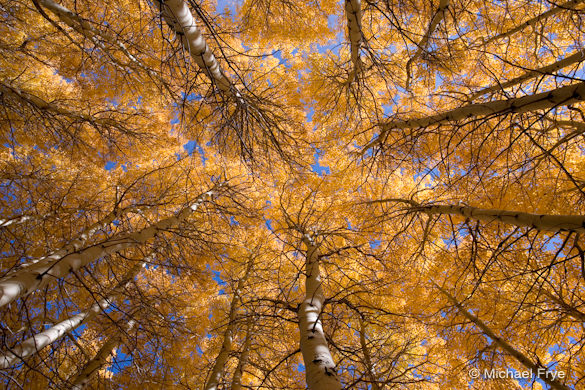
Aspen Grove, June Lake Loop, October 23rd, 2006
And if the aspens don’t produce more great color this year, there are always maples, dogwoods, oaks, and cottonwoods in Yosemite Valley. Peak fall foliage in the valley doesn’t usually occur until the end of October or beginning of November, but the rain and cold temperatures have set things in motion, and many maples and dogwoods have already started to change color. It looks like autumn might arrive early in the valley this year, but these things are always hard to predict.
I’m hoping to try again to get over to the east side later this week, so I’ll let you know what I find. In the mean time, a good resource for fall color reports is the Calphoto web site. Also, if you’ve been photographing aspens recently, or captured some of the storm activity in Yosemite, please use the comments to tell us what you found, and post links to photos!
by Michael Frye | Sep 20, 2010 | Yosemite Photo Conditions
Aspens and Juniper, Rock Creek Canyon
Claudia and I went to the Millpond Music Festival in Bishop this weekend. We were trying to figure out how many years we’ve been going to this event. Eleven? Twelve? Regardless, we love this festival. Crowds are small, the camping is great, and we get to spend time with friends. Oh, and the music is wonderful!
On our way home last night we drove up Rock Creek Canyon, as I had read a report by Inge Fernau on Carol Leigh’s Calphoto site about some early color there. We did find some aspens changing. They were mostly small, scrubby ones near the trailhead, but I was able to make this photo of yellow leaves surrounding a juniper.
It’s still very early for fall color, but by the end of the month the high-elevation aspens on the eastern side of the Sierra should turning. I’ll keep you posted on what I see and hear.
by Michael Frye | Sep 16, 2010 | Yosemite Photo Conditions
Late-October aspens, June Lake Loop
As fall approaches, you might be wondering where and when to photograph fall color around Yosemite. Click here to read my post from last September describing some of my favorite autumn locations.
It’s too early to tell what kind of fall we’ll have. Some of the Indian rhubarb in Yosemite Valley has already turned yellow, which is a bit early. I’ll be going to Bishop this weekend for the Millpond Music Festival, so I’ll let you know if I see any high-elevations aspens staring to change color.
Let’s hope for a nice fall!
by Michael Frye | Sep 1, 2010 | Yosemite Photo Conditions
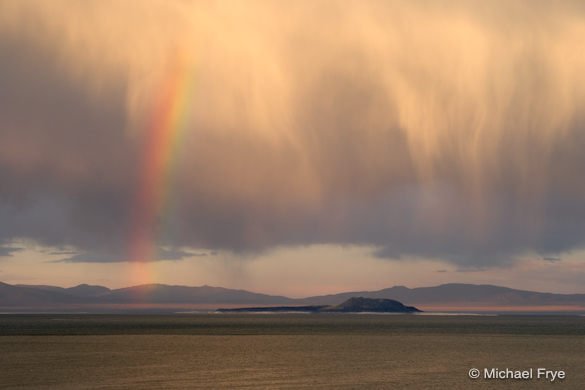
Rainbow over Mono Lake, September 7, 2006
It’s September 1st, a milestone for photographers in the northern hemisphere. Technically it’s still summer, and in most of the United States the weather remains warm. In Yosemite the waterfalls are barely flowing, and fall color is still at least a month away.
But the the light is changing. Every day is a little shorter than the previous one. Gradually the sun is taking a lower path through the sky. Sunrises and sunsets last longer. For the next eight months the sun won’t be directly overhead anymore during the middle of the day, beaming down harsh, unflattering light on our favorite subjects. Best of all, we won’t have to get up so early for sunrise!
So although summer isn’t officially over yet, it’s days are numbered. Here’s to more interesting light in the months to come.










